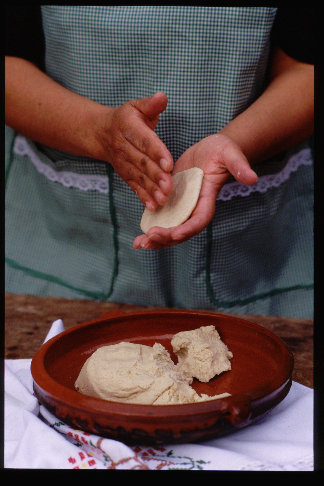
Photo: Laurie Smith
Tortillas
Article from the Oldways Table, Oldways Preservation Trust, http://www.oldwayspt.org/
Daily bread is a window on the soul. At least that’s true of Mexican tortillas. They were the people’s bread centuries before they received a Spanish name meaning “little round cakes.” Like French loaves, Arabian pita, or Indian chapatis, they have powerful symbolic meaning for the entire culture.
Tortillas basically consist of alkali-treated corn kernels (nixtamal) ground to make a dough (masa), patted into small rounds, and baked on a griddle (comal). Everything that goes into them is an emblem of tradition dating back to pre-Hispanic times: The majestic corn plant; the stone metate over which generations of women knelt to grind the treated kernels; the skilled actions of forming the round, sliding it onto the comal, and flipping it with a quick pressure of the hand to make it puff slightly. Tortillas are “slow cooking” at its most archetypal — that is, the actual cooking takes only seconds, but the soaking and patient, laborious grinding traditionally occupied hours of every day.
The genius of pre-Hispanic cooks played hundreds of regional and other variations on this simple food — using different kinds of corn, separating out the delicate starch, working other ingredients into the dough, molding all kinds of shapes, pleating the surface, coating the tortillas with flavorful sauces, rolling or forming them around fillings. Every crumb of leftover tortilla went into still other dishes.
In a few remote regions you may still find women soaking their own corn, grinding masa on a metate, and expertly patting out the dough between their palms or on a bare knee. But the tortilla hasn’t exactly stood still over the centuries. The first big change was the introduction of wheat by the Spanish. This created the flour tortillas that people in northern wheat-growing states love the way other Mexicans love corn tortillas. Another novelty was European cooking fats like lard, for working into flour dough or for frying. Soon cooks learned to combine corn masa with wheat flour for special tortilla variations like gorditas that puffed up into delicious balloons when fried.
For about a century, machines have been superseding the daily labor of preparing tortilla dough. First came small commercial mills to grind the masa, sparing housewives hours bent over the metate. Handle-operated presses replaced manual patting-out almost everywhere. Meanwhile, manufacturers devised instant “flour” mixes from dried corn masa — Maseca, Quaker Masa Harina, and others. Many companies started making pre-formed packaged tortillas, both wheat-flour and corn.
Today tortillas of true non-instant masa are virtually extinct in the United States and only sometimes to be found in Mexico. Corn tortillas made from dried mixes are now the norm. Even in my own restaurant, we are no longer able to make tortillas from real masa.
It’s a sad loss. In the state of Oaxaca there’s a movement to bring back artisanal masa, and I’d rejoice if it could spread to this country. Meanwhile, we all make do — and I have to say that in some tortilla variations traditionally made with a combination of masa and some flavorful starch like mashed beans or plantains, the absence of fresh masa doesn’t matter as much. Here is one of my favorites, the Tortillas de masa y plátano verde from Veracruz.

